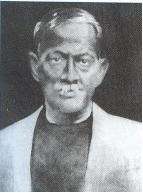Nagendra Prasad Sarbadhikari
| Nagendra Prasad Sarbadhikari | |
|---|---|
 | |
| Born |
6 August 1869 Kolkata, India |
| Died | 17 January 1940 (aged 70) |
| Nationality | India |
Nagendra Prasad Sarbadhikary,[1][2] who is now known as the father of Indian football for his role in introducing soccer as a teenager in the year 1877 at Hare School, Calcutta.[3][4] It is he who mobilized his classmates and started playing the game at the Hare School compound. Attracted by the enthusiasm of the boys in the school, the European teachers of the school and adjacent colleges encouraged Nagendra Prasad and his companions to promote the game among students in and around Calcutta. The Boys' Club, founded by Nagendra Prasad around this time, was the first Indian initiative at football organization.
Later he formed a string of sporting clubs in Calcutta in the 1880s, one of the first being the Wellington. Moni Das was one of the first members to be inducted by Nagendra Prasad to the Wellington club, but, the other members of the club protested about playing with this man as he was from the lower caste. Sarbadhikary said that a sporting ground is beyond any prejudice. But he was however forced by the members' protest to dismantle the Wellington Club in 1884. Soon after, 500 members left and Nagendra Prasad founded the Sovabazar Club, one of the leading sports institutions of colonial India. The first member of this new club was Moni Das. He later captained the Mohun Bagan Club, yet another legendary institution of sports in India, colonial and post colonial. Thus a man from the lower caste, through cricketing prowess and sport broke into the upper echelons of the Hindu society.
References
- ↑ "Legends Of Indian Football : The Pioneers". The Hard Tackle. Retrieved 2 July 2014.
- ↑ "Passion Play in Kolkata". Forbes India Magazine. Retrieved 9 July 2014.
- ↑ "FOOTBALL IN BENGAL". The Indian Football Association (West Bengal). Retrieved 7 February 2015.
- ↑ "Football". Department of Sports, Government of West Bengal. Retrieved 7 February 2015.